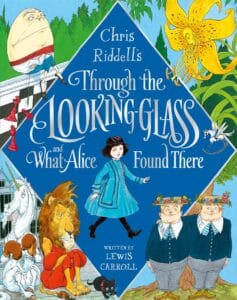
Book Summary
Through the Looking-Glass, and What Alice Found There is a wonderful book written by Lewis Carroll. It is the sequel to Alice’s Adventures in Wonderland and follows the adventures of a young girl named Alice. In this book, Alice enters a magical world through a mirror and encounters many strange and interesting characters.
This book is full of excitement and imagination! Alice’s journey through the looking-glass takes her to a world where everything is topsy-turvy and nothing is as it seems. She meets talking flowers, a grumpy Red Queen, and even a silly Humpty Dumpty. Each encounter brings a new adventure and keeps you hooked until the very end.
The story is filled with clever wordplay and funny situations that will make you laugh out loud. Alice’s curiosity and bravery make her a lovable character that you will root for throughout the book. The illustrations in the book are also beautiful and help bring the story to life.
Through the Looking-Glass is not just a fun story, but it also teaches us important lessons. It shows us that sometimes things may seem confusing or impossible, but with determination and a positive attitude, we can overcome any obstacle. Alice’s journey teaches us to be brave, to believe in ourselves, and to never stop exploring the world around us.
The book is also filled with puzzles and riddles that will challenge your mind. It encourages you to think creatively and to look at things from different perspectives. It’s a great book to read if you enjoy solving mysteries and using your imagination.
Lewis Carroll, whose real name was Charles Lutwidge Dodgson, was a famous English writer and mathematician. He was born in 1832 and wrote many books, but Alice’s Adventures in Wonderland and Through the Looking-Glass are his most well-known works. Carroll’s stories have been loved by children and adults for generations and continue to inspire new adaptations and movies today.
“Through the Looking-Glass, and What Alice Found There” is a novel written by Lewis Carroll, a sequel to his earlier work, “Alice’s Adventures in Wonderland”. Published in 1871, this novel continues the adventures of Alice, a young girl who finds herself in a fantastical world filled with anthropomorphic creatures and nonsensical situations. The novel is a classic example of the literary nonsense genre, combining elements of logic, fantasy, and satire to create a unique and enduring work of fiction.
“Through the Looking-Glass, and What Alice Found There” is a delightful and imaginative journey that takes the reader into a world where the ordinary becomes extraordinary. The novel begins with Alice idly playing with her kittens when she suddenly finds herself in a mirror-image world, where everything is reversed. Here, she encounters a variety of peculiar characters, including talking flowers, sentient chess pieces, and the enigmatic Red and White Queens.
The narrative is filled with whimsical wordplay, riddles, and poems, including the famous “Jabberwocky”, which has become one of the most celebrated pieces of nonsense verse in the English language. The novel’s episodic structure, with Alice moving from one bizarre situation to another, keeps the reader engaged and curious about what will happen next.
Despite its fantastical elements, the novel also touches on themes of growing up and the confusion and challenges that come with it. Alice’s journey can be seen as a metaphor for the transition from childhood to adulthood, with all its accompanying trials and tribulations. The novel’s ending, where Alice wakes up to find that her adventures were all a dream, leaves the reader with a sense of nostalgia and a longing for the innocence and wonder of childhood.
“Through the Looking-Glass, and What Alice Found There” is a rich and complex work that can be analyzed on multiple levels. On the surface, it is a children’s story filled with amusing characters and absurd situations. However, a deeper analysis reveals a sophisticated exploration of themes such as identity, reality, and the nature of language.
The novel’s setting, a mirror-image world, serves as a metaphor for the distorted and often confusing perceptions of reality that we all experience. Alice’s encounters with the inhabitants of this world, who often speak in riddles and contradictions, highlight the arbitrary and subjective nature of language and meaning.
The character of Alice is a representation of the child’s perspective in a world governed by adult rules and conventions. Her constant questioning and challenging of the nonsensical logic of the Looking-Glass world reflect the natural curiosity and skepticism of children. At the same time, her journey can be seen as a coming-of-age story, with Alice learning to navigate and make sense of a world that often seems illogical and unpredictable.
The novel’s use of satire and parody also deserves mention. Carroll uses these literary devices to poke fun at the conventions and hypocrisies of Victorian society, making the novel a subtle social commentary as well.
Lewis Carroll, whose real name was Charles Lutwidge Dodgson, was an English writer, mathematician, logician, and photographer. He is best known for his “Alice” books, which have become classics of children’s literature and have been translated into over 100 languages. Carroll’s unique blend of logic, fantasy, and nonsense has had a profound influence on subsequent writers and has earned him a place among the most celebrated authors in the English language.
Carroll was also a pioneer in the field of photography and is considered one of the best amateur photographers of the Victorian era. His photographs, like his writings, often reflect his fascination with the world of children and his ability to see things from their perspective.
Despite his success as a writer, Carroll remained a somewhat enigmatic figure throughout his life. He was known for his shyness and his preference for the company of children over adults. His writings, with their blend of whimsy, satire, and profundity, continue to captivate readers of all ages.
Don Quixote by Miguel de Cervantes
Miguel de Cervantes
Read Now →